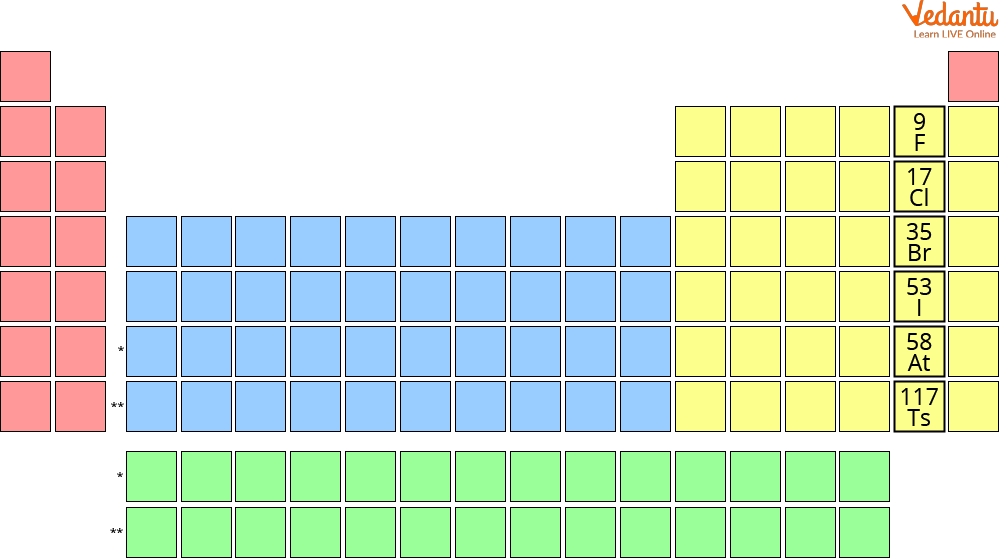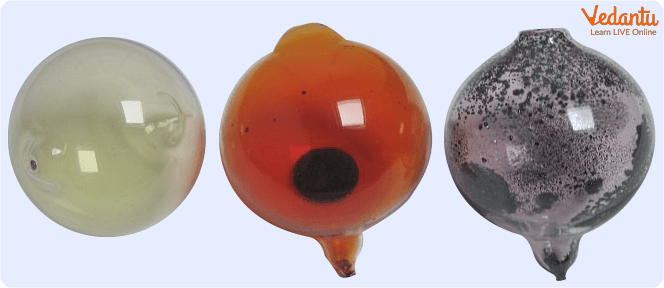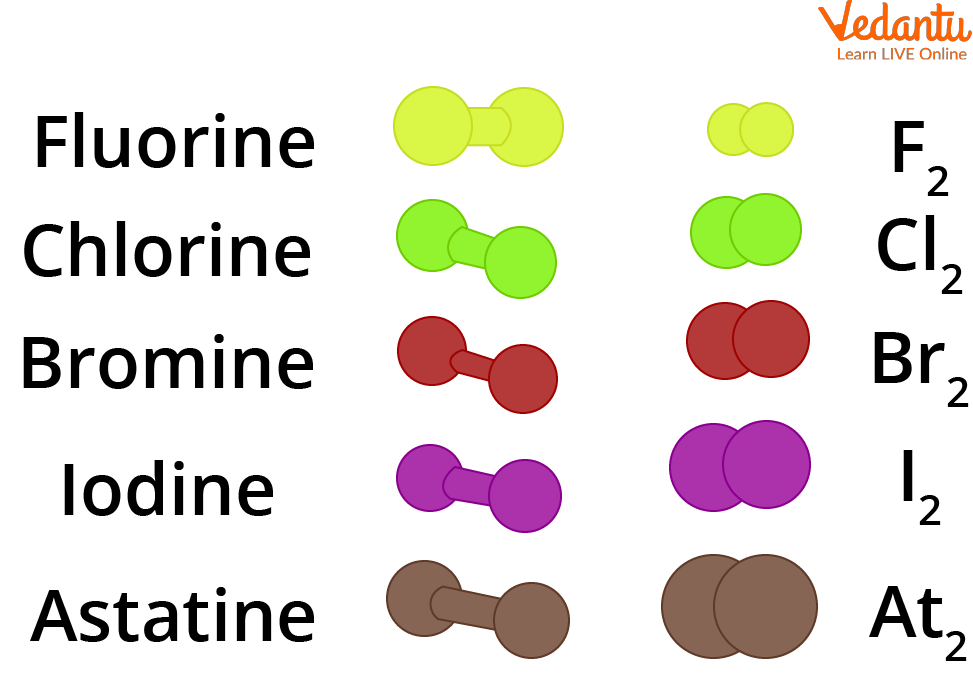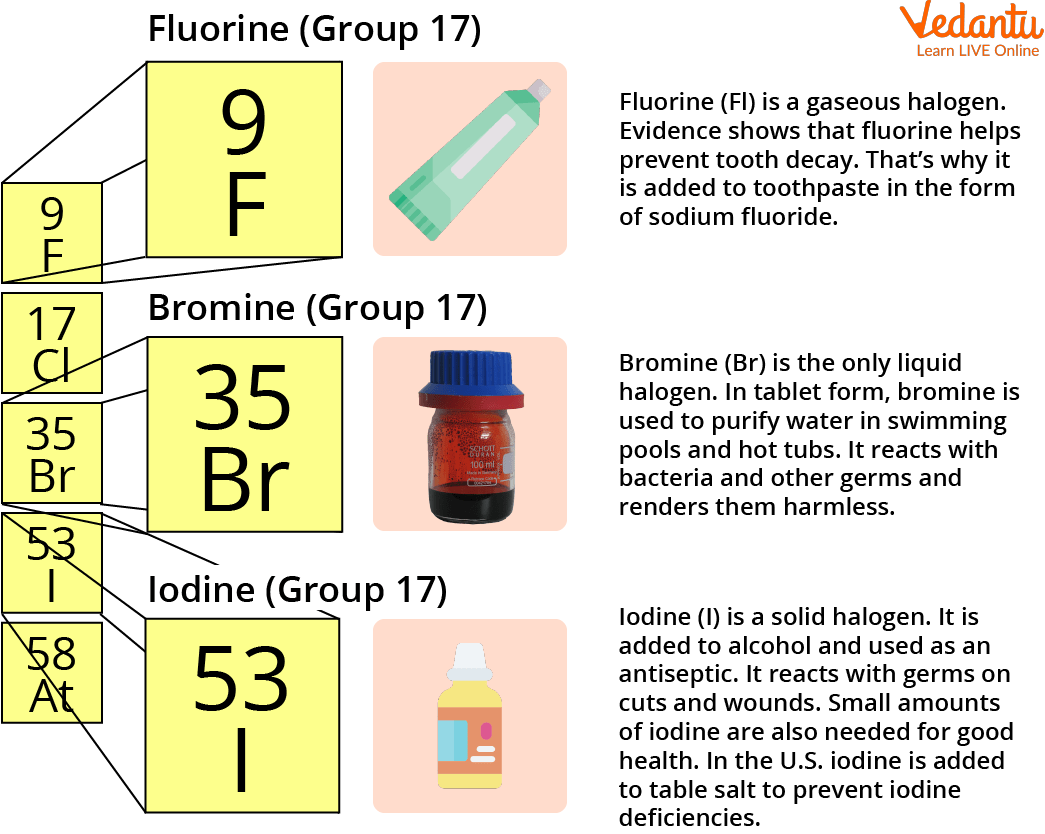




What are Halogens?
Halogens make one of the most important topics in Chemistry. Now, what are halogens? Let us read Halogen’s definition. Halogens are the six chemical elements in group 17 (VIIA) of the periodic table. They exhibit comparable chemical properties, for example, by producing sodium salts that are highly similar to one another (Na). Therefore, it gets its name from the Greek terms hals, which means "salts," and genes, which means "origin."

Periodic Table Depicting the Group 17 Halogens
Halogens have been used by humans since ancient times, even before having a deep chemical knowledge that allowed us to distinguish or study them better. They were mainly used in the form of salts, which the ancient Phoenicians and Greeks used as a method of preserving food (brine). Here we will discuss various halogens properties, uses, and examples.
Which Chemical Elements Belong to the Halogen Group?
The halogen group has six elements:
Fluorine (F)
Chlorine (Cl)
Bromine (Br)
Iodine (I)
Astatine (At)
Tennessine (Ts)
Physical Properties of Halogens
The halogens are a diverse group and can be found at room temperature and pressure in all three states of matter:

Halogens are Present in all Three States of Matter in Nature
Gassy: Fluorine and Chlorine.
Liquid: Bromine.
Solid: Iodine and astatine.
Regarding colour, they range from pale yellow (fluorine) and yellowish green (chlorine) to brownish red (bromine) and violet or black (iodine). Astatine, on the other hand, is an unstable, radioactive element that does not have a long enough half-life to be seen. On the other hand, Tennessee is a synthetic element whose properties are still being studied.
Chemical Properties of Halogens
Due to their high reactivity, halogens are seldom seen in their monoatomic state but rather as a component of other compounds. They may create diatomic molecules of the same element, at most. F2, Cl2, Br2, and I2, for instance.

Shapes of Halogen Molecules
Halogens create monovalent ions (-1), meaning they lack the last electron needed to complete their energy level. They are all oxidising substances as a result. On the Pauling scale, its electronegativity is 2.5 as well (or less). The most electronegative element is fluorine. The decreasing order of electronegativity F>Cl>Br>I is what is the order of electronegativity among halogens.
What are Halogens used for?
The uses of halogen elements are numerous. To cure wounds, sanitise surfaces, and safeguard swimming pools and spas, disinfectants like chlorine and bromine are utilised. Both of these substances are frequently employed as flame retardants. Bleach also contains chlorine. Halogen lamps use iodine and bromine to provide a brighter glow than ordinary incandescent lights. In pharmaceuticals, halogens are employed. Nuclear medicine uses the isotopes of astatine and iodine. The photography business uses brominated chemicals (bromides) as a material and as sedatives.
Iodine has antibacterial halogen properties.
In the meanwhile, fluorine is utilised to create Teflon resins, lubricants, and antifreeze.

The Uses of Halogen Elements
Examples of Everyday Substances with Halogens
Aerosols once included the halogen-containing chemical CFC.
Some well-known halogen-containing compounds include:
Common salt or table salt (NaCl). It is used to season meals and is edible.
Silver nitrate (AgBr). Because of its photosensitivity, it is employed in photography.
Fluoride in calcium (CaF2). It is utilised in the metallurgical processing of iron and steel.
CFCs, or chlorofluorocarbons. They belong to a group of gases that were historically utilised as aerosol propellants and in refrigeration.
Summary
Halogens are located on the periodic table's right side, just to the left of the noble gas group. Group VII, often known as group 7, or group 17 in more recent IUPAC terminology, designates the halogens. Halogens are all nonmetallic substances. They create brittle solids and have poor heat and electrical conductivity. There is liquid bromine. Astatine and iodine are both solids. Tennessee is thought to be solid by scientists. As a result, the halogen group is the only elemental group that, at ambient temperature and pressure, includes all three of the usual states of matter.
FAQs on Halogens - The 17 Group of Periodic Table
1. What halogen weighs the most?
The heaviest known halogen, denoted by the letter At, Astatine, is also the least reactive and most metallic of the group of halogens. Since astatine was ultimately identified, it has been decades, but questions still surround the substance.
2. Why is fluorine called halogen?
Fluorine is the most reactive of all the halogens. It combines directly with every other element except oxygen and some of the noble gases. Hence fluorine is called a super halogen element. As the most electronegative element it's extremely reactive.
3. Are halogens toxic?
Halogens are widely used in commercial applications around the world; however, they are extremely toxic and present a significant threat to human health when released accidently or intentionally as chemical weapons during acts of terrorism.
4. Are halogens poisonous?
Halogens are often utilised in industrial settings all over the world, but when they are accidentally or purposefully released as chemical weapons during terrorist attacks, they are exceedingly poisonous and pose a serious threat to human life.









